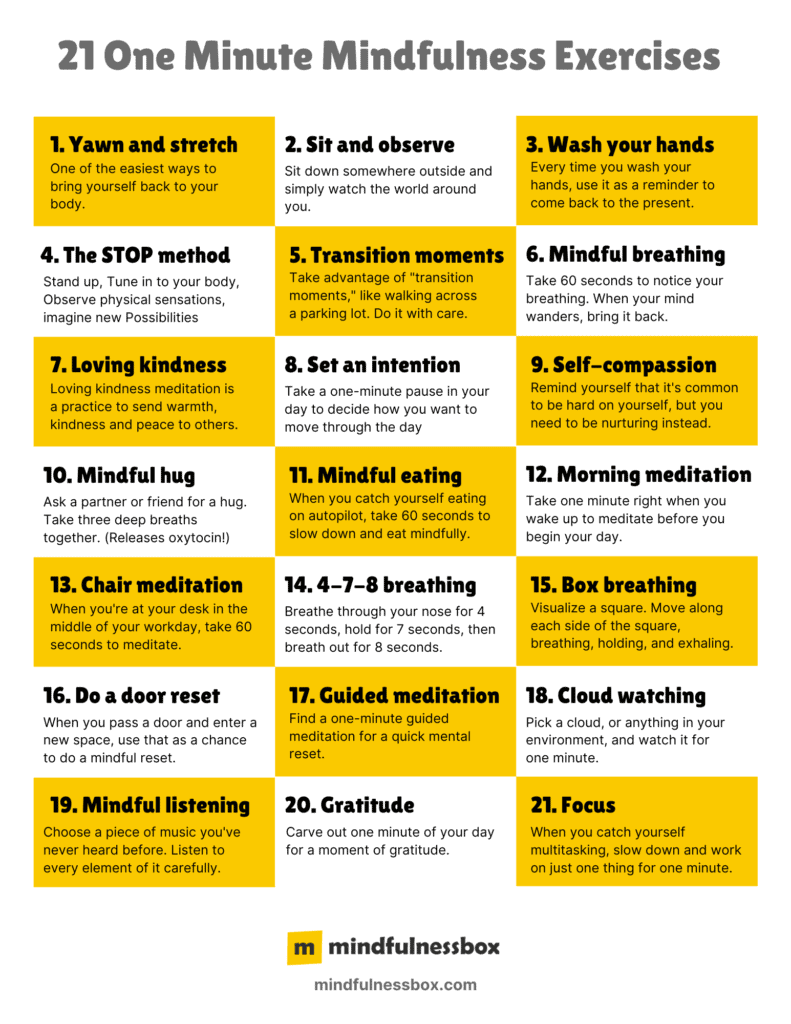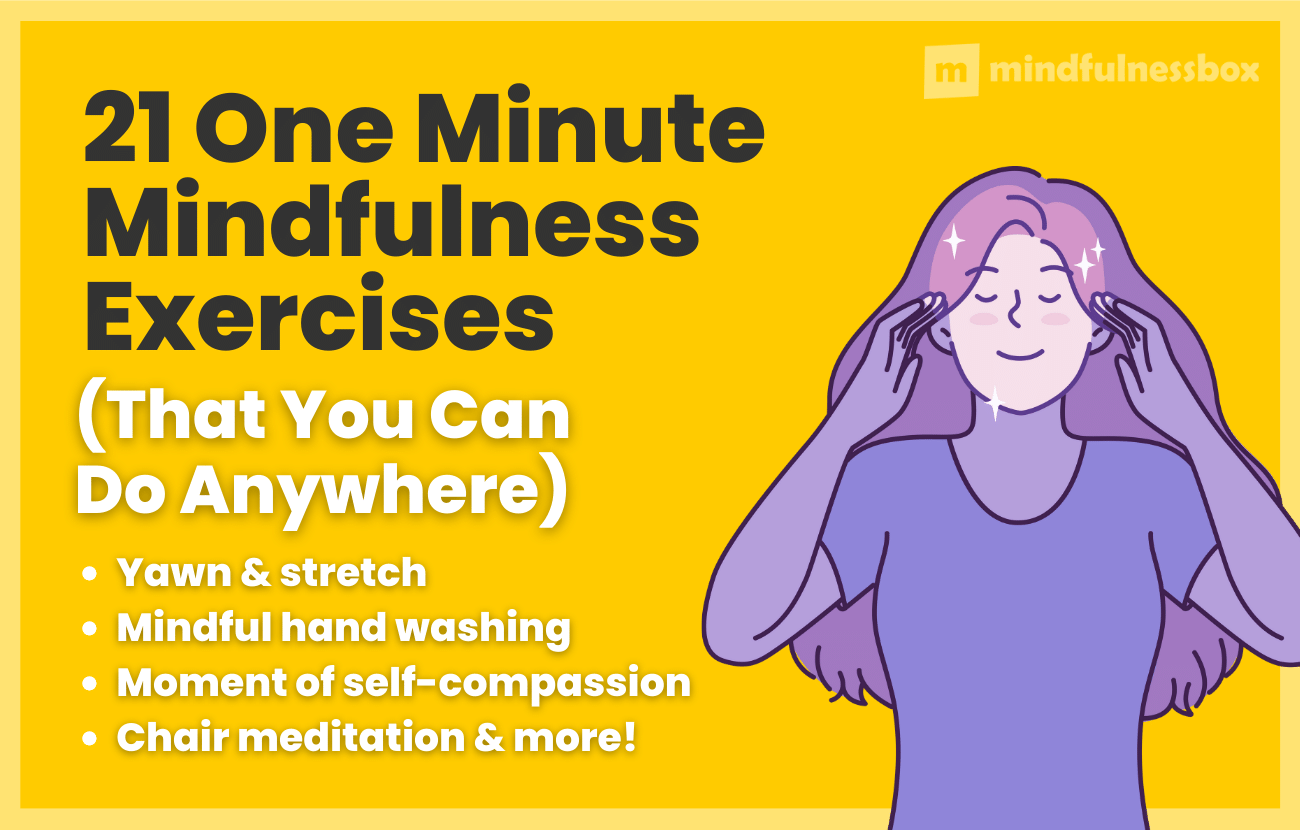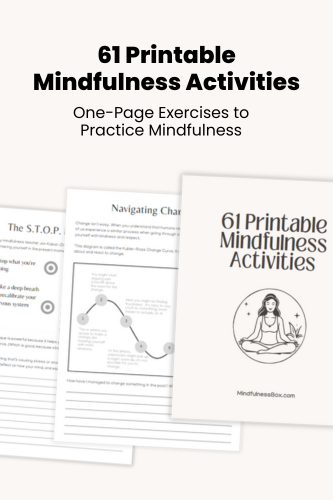A one minute mindfulness exercise is anything you can do in 60 seconds or less to center yourself, ground yourself, and pull yourself into present awareness. These short mindfulness exercises help you incorporate the principles of mindfulness into your life — especially when you’re short on time.
In an ideal world, every day we would have enough time and energy to meditate, write in a gratitude journal, do yoga, and pay attention to each moment of our day with mindful awareness.
Wouldn’t that be nice!
Get dozens of one-page exercises to help practice mindfulness, meditation, gratitude, and self love. Perfect for printable handouts when teaching mindfulness to groups, students, or in the workplace.
To see examples, plus a full list of the 61 exercises included, click below.
Of course, it doesn’t always work out like that. Many of us struggle to fit mindfulness into our schedules.
That’s why I created this list of mindfulness moment ideas: it’s full of simple mindfulness exercises like 1 minute breathing exercises. If you frequently find yourself without time for your mindfulness practice, it may be time to incorporate these easy mindfulness exercises into your routine.
21 one minute mindfulness exercises
Let’s explore some specific mindfulness minute activities below.

1) Yawn and stretch
First, fake your yawn. It may feel funny, but a fake yawn will lead to real ones.
Yawns interrupt your normal thought processes and feelings for a moment as your body’s automatic processes take over completely.
Notice how the brief pause that comes from yawning feels.
Stretch while you yawn—slowly, for 20 seconds, holding the stretch longer than you think you need to. Notice any areas of your tightness in your body, and ease them into relaxation. Then, take a few moments to come back to reality, setting the intention to be present.
2) Use the Forrest Gump technique (sit and observe)

Forrest Gump famously sat on a bench outside while narrating the movie of the same name.
I’ll admit, that’s pretty much where this metaphor breaks down—but we don’t know for sure that he wasn’t observing all his senses on that bench.
In any case, this is a great technique to use while you’re waiting for something.
If you can find a bench to sit on, or any spot outside really, take a moment to check in with your five senses. What does the bench feel like? Can you feel the wind against your skin? How about the vegetation and trees around you – can you smell them? Are there birds, and are they singing? There may not be much to taste unless you have a coffee with you, but do your best to pick up any lingering taste in your mouth.
Done with enough intention, you’ll get a taste of mindfulness in a minute from wherever you’re sitting.
3) Wash your hands mindfully
Let’s get real: sometimes it can be hard to remember to put new ideas into practice.
If you remember one idea from this list, make it mindful handwashing.
Sure, it’s one of the most basic mindfulness exercises.
But it’s worth it to bring it into your routine for a couple reasons. First, you’re pretty likely to have a private, quiet moment in the bathroom when washing your hands. And second, it’s something that happens multiple times each day, so it can be a great moment to do a mindful check in.
When you get to the sink to wash your hands and see yourself in the mirror, set the intention for that to be a trigger to come back to the present. Slowly turn on the tap, feeling the temperature of the water. Lather soap onto your hands with care, rather than quickly. Then slowly rinse your hands, and turn the tap off.
The key is to linger on each part of this process, noticing how it feels to turn an everyday, automatic activity into something you truly give your attention to.
4) Use the STOP method
The STOP method is a mnemonic for slowing down and tuning into yourself, your feelings, and your body. You can do it in as little as a minute. Here’s how it works:
(S) Stand up and breathe.
(T) Tune into your body. See how it feels. Notice that it’s connected to the Earth. Notice any physical sensations.
(O) Observe. What physical sensations do you have? Are they positive, or negative?
(P) Possibility. Ask yourself what is possible in this moment. Can this be a turning point for the rest of the day?
5) Take advantage of transition moments

One of my favorite short essays of all time is How to Walk Across a Parking Lot, by David Cain. It explores turning the mundane into magic by reimagining the most boring, utilitarian experience imaginable. When walking across a parking lot, all we want is for the experience to be over, to get to where we’re going. But what if we didn’t look at it like that?
Transition moments like this are abundant in our lives. We rarely notice their potential to turn into something greater, to be an experience unto themselves.
So whether you’re walking across a parking lot, riding the elevator, waiting in line to check out at a store, or even waiting for your coffee to finish brewing, ask yourself: how can I immerse myself in this moment? What do I notice about it? And how is this moment different when I pay attention to it, versus when I don’t?
6) Mindful breathing for one minute
Take a moment, wherever you are, to breathe consciously and mindfully.
It seems like it should be natural, but breathing is an automatic process, so to really pay attention is a different experience.
First, lower your eyes, and notice where your breath is. Perhaps it’s in your nostrils, or maybe you feel it more in your stomach, or your chest. Second, breathe a little deeper and longer than you usually do. Notice how it feels. Third, when your mind wanders away from focusing on breathing (as it tends to do), gently come back to your breath.
7) Loving kindness meditation
Loving kindness meditation is a practice to send warmth, kindness and peace to others.
Typically, this is done by picking a mantra and repeating it. It can be anything you feel comfortable with, along the lines of “I’m wishing you happiness and kindness and peace.” It’s sometimes easier if you start with someone you have unreservedly caring feelings for: it can be your child, or even a pet. Then, move your loving kindness meditation to focus on someone you feel neutrally about. Finally, you can send it out to everyone in the world.
Do this for one minute.
8) Set an intention
Take a one-minute pause in your day to decide how you want to move through the day. What energy do you want to have? How do you want to be present with those around you?
For example, you may say “I am going to radiate joy and be contagiously positive to those around me today. I am going to make their lives better by being around me.” Or even simply, “Today, I choose to treat everyone I encounter with kindness and respect.”
You may have already set an intention at the beginning of the day. If so, just guide yourself back to your original intention.
9) Take a moment for self-compassion
Oftentimes, we don’t show ourselves enough compassion.
It can be easy to beat yourself up for mistakes in the course of the day. “I should have done this; I wish I’d done that. I should be more responsible. How could I let that happen?”
Self-compassion is a way to treat yourself like you would treat a dear friend, or a child. In just one minute, the CAN mnemonic can help you show yourself compassion.
Here’s how it works.
(C) it’s Common to feel like this. In the first step, you reassure yourself that everyone has moments like this.
(A) bring Awareness to your breath and your body. Ground yourself.
(N) be Nurturing to yourself. Place your hand on your heart, or give yourself a hug. Tell yourself, “It’s okay. You’re okay. It’s normal to feel the way you’re feeling. This will pass.”
10) Take a moment for a mindful hug
If you have a partner, a relative or close friend who is able to support you, ask them for a hug and take three big breaths together.
Holding another person and breathing together even for as little as 20 seconds can balance your nervous system, and the connection can release oxytocin.

11) Mindful eating
In the middle of a meal, check in with yourself and notice how you’re eating. Are you eating quickly? Are you paying attention to the texture and flavor of the food and drink?
It’s easy to eat automatically instead of mindfully. When you catch yourself doing this, it may be a good time to take a mindful eating minute. Take a piece of food and savor it, noticing how it tastes and smells. Eat slower than normal, and notice how the meal feels as you slow down.
You can take 60 seconds to practice mindful cooking, too.
12) Meditate right when you wake up

As you’re layering mindful moments into your day, you may find that habit stacking can help you easily and automatically find yourself being aware of your surroundings more often. Habit stacking, per author James Clear, is a method of connecting habits you already have with habits you want to adopt.
For example, “when I wash my hands, I’ll take one moment to be mindful.”
In the same way, meditating upon waking up can be a great start to the day, and as simple as a one-minute body scan meditation.
Stretch, and pay attention to each individual part of your body from your head to your toes. Notice how each part feels. Do this over the course of a minute, while breathing deeply.
13) Meditate in a chair
Looking for mindfulness exercises at work? Sitting meditation while in a chair is a one minute meditation that’s tailor-made for you.
Put your feet flat, sit comfortably in your chair with good posture, close your eyes and focus on your breathing. As your mind wanders away from your breath, gently bring it back.
This mindful observation exercise can be done in the middle of the workday when you have 60 seconds to yourself.
14) Use 4-7-8 breathing
The 4-7-8 breathing technique is intended to calm your nervous system, and provide a mindful moment through the experience of breathing.
It’s a powerful, easy-to-remember 1 minute meditation.
Make yourself comfortable while sitting or lying down, then breathe through your nose for 4 seconds. Hold your breath for 7 seconds, then breath forcefully out for 8 seconds.
In one minute, you can do three cycles of 4-7-8 breathing.
15) Use Box Breathing
Box breathing is similar to 4-7-8 breathing, but shorter, and includes a visualization exercise to simplify things.
Start by visualizing the left side of a two-dimensional square, and inhale to the count of 4. As you inhale, head to the top of the square in your mind’s eye. Then, hold your breath for 4 seconds, heading towards the right side of the square. Exhale for 4 seconds, heading down the right side of the box. Then hold for another 4 seconds at the bottom of the box, before starting the process again.
You can do as many as four rounds of box breathing in one minute.
16) Take a moment to reset as you walk through a door
How many doors do you walk through in a day? Cars, rooms, houses, offices—it can be anything.
This technique was developed by Jan Chozen Bays, author of a mindfulness book called How to Train a Wild Elephant.
Here’s how it works:
When you walk through a door and enter a new space, use that moment as a trigger to remind yourself you want to be mindful.
Pause, take one breath, and be aware of the differences between the space you left, and the space you are now entering. Then, continue.
17) Do a one-minute guided meditation
Some mindfulness apps offer guided meditations that are as short as one minute.
For example, here’s one from Insight Timer, described as allowing you to “Take a serenity break for 1 minute with Quartz Crystal Bowls and a soothing voice. Relax and witness the stress melt away.
Quick meditation exercises like this have the potential to pull you into a whole different way of being in just 60 seconds.
18) Take a mindful observation minute
Pick something in your environment, and choose to pay attention to it for a minute.
This may be easier outside, but can be done inside too, looking out a window. You might watch a cloud float by in the sky, or the journey of an ant, or the way a flower sways in the breeze. If your attention moves on from the object, gently bring it back.
This simple exercise can help you experience your environment in a more profound and meaningful way. Done enough, it can start to become automatic.

19) Take a mindful listening minute
Choose a piece of music you’ve never heard before, and set an intention to really listen to it: the feeling of the song, the instruments involved, the intention behind the words.
Here’s one strategy:
Pick out one instrument among the many that you hear, and see if you can follow along with it separately, rather than letting it blend in with all the others.
Listen nonjudgmentally and without expectation.
20) Take a moment of gratitude
Carve out a moment in your day for gratitude.
It doesn’t just have to be gratitude about the big things in life, like your health and your family.
Gratitude is powerful even if you’re just expressing thanks for the things in your day that normally go unappreciated:
- Your air conditioner is working
- You have a warm lunch to eat
- You have a beautiful view out your window
- You have a clean home
Anything that can be appreciated counts.
For more, check out our list of 101 reasons to be grateful.
21) Take one minute to work on a single task
Trying to do multiple tasks at once is usually a counterproductive way to work.
When we multitask, our attention is divided and we are less effective overall.
If you catch yourself in a moment of heated multi-tasking, slow down and set an intention to work on a single task for one minute.
As you get distracted, gently bring yourself back to the task at hand.
What’s next?
You made it this far- want to keep your mindfulness practice going? Check out these one minute meditations.
Frequently asked questions
What is a mindful minute?
A mindful minute is a mindfulness exercise of one minute or less. These brief routines help you incorporate the principles of mindfulness into your life. Often, these take the form of breathing exercises or awareness and grounding techniques.
It can be difficult to integrate mindfulness meditation exercises into your everyday routine, whether you’re juggling responsibilities at work or spending time with your family, pets, or loved ones. Even if it’s just for a minute, these exercises may serve as reminders to stay grounded and present throughout the day.
How do you take a mindful minute?
One common way to take a mindful minute is to find a comfortable place to sit, stand or lie down. Once you’re comfortable, close your eyes and focus on your breath. Inhale deeply through your nose, and exhale fully through your mouth. As you inhale, imagine the breath entering your body and filling up your lungs. As you exhale, imagine all of the stress and tension leaving your body with the breath. Try to do this for at least one minute.
You can do this or similar quick mindfulness activities anywhere: in your office chair, in your parked car, while eating. You may find you need to create space for your mindful minute by sneaking away to the bathroom for a bit of quiet and privacy. In this case, you can do breathing exercises in the bathroom, or even turn the act of washing your hands into your mindful minute.

My mindfulness practice kicked off in 2016 with a ten-day silent retreat. Since then, I’ve read dozens of books about mindfulness and completed hundreds of hours of meditation. Thinking about what makes humans happy, calm, and peaceful is endlessly fascinating to me.


